| Columns Retired Columns & Blogs |
Gershman Acoustics Opera Sauvage loudspeaker Measurements
Sidebar 3: Measurements
Measured on its tweeter axis, the Gershman Opera Sauvage was of average voltage sensitivity, at an estimated 87dB(B)/2.83V/m. This is 2dB below the specified figure. However, my figure is in line with that implied by Gershman's own measurements of the Opera Sauvage at Canada's NRC, which they kindly enclosed with the review samples. Gershman also specified the speaker as an 8 ohm load, but this is misleading. Both the NRC measurements and my own (fig.1) suggest that a 4 ohm rating would be more appropriate. (Gershman has subsequently revised the specification to 4 ohms.) In addition, as the impedance drops below 4 ohms for the entire midrange, reaching a minimum value of 2.73 ohms at 525Hz, a good, beefy amplifier in terms of current delivery is mandatory for driving the Opera Sauvage. This graph also shows that the electrical phase angle gets a bit extreme below 25Hz; however, as there is very rarely any significant energy in that region (LP record warps aside), this should not unduly tax the amplifier.
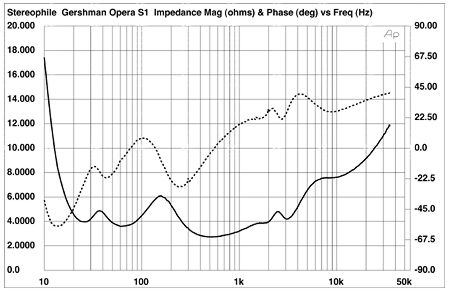
Fig.1 Gershman Opera Sauvage, electrical impedance (solid) and phase (dashed) with rear-panel switch On (2 ohms/vertical div.).
This graph was taken with the rear-panel switch set to its On position. Switching it to Off raised the impedance slightly throughout the treble, but didn't change the shape of the impedance curve. No wrinkles can be seen in the impedance traces, which would indicate the presence of mechanical enclosure resonances. However, investigating the panels' vibrational behavior with a simple plastic-tape accelerometer revealed that some resonant modes are present on both the front baffle and the bottom half of the sidewalls. Fig.2, for example, is a cumulative spectral-decay plot taken with the accelerometer fastened just below the woofers on the baffle. Two strong modes can be seen, at 160Hz and 195Hz. The 160Hz mode could also be detected on the sidewalls level with the bottom woofer, as well as a lower-level mode at 240Hz.
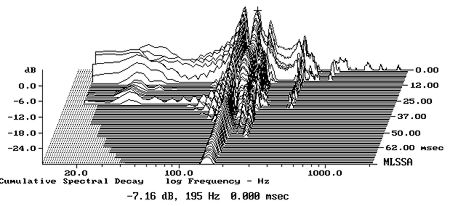
Fig.2 Gershman Opera Sauvage, cumulative spectral-decay plot calculated from the output of an accelerometer fastened to the cabinet's front baffle beneath the woofers (MLS driving voltage to speaker, 7.55V; measurement bandwidth, 2kHz).
The saddle centered on 30Hz in the fig.1 impedance trace suggests that this is the tuning frequency of the big rectangular port at the base of the speaker's rear panel. This was confirmed not only by the nearfield measurements of the woofers' output, which shows the expected notch at this frequency (fig.3, green trace), but also of the port, which peaks in the same region (fig.3, blue trace). The port's output is clean above its passband. While the woofers' output has some slight peakiness evident in the midrange, this is suppressed by the crossover and probably won't have any audible consequences.
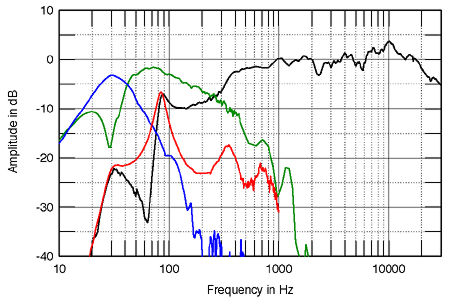
Fig.3 Gershman Opera Sauvage, acoustic crossover on tweeter axis at 50", corrected for microphone response, with the complex sum of the nearfield midrange, woofer, and port responses, taking into account acoustic phase and distance from the nominal farfield point, plotted below 300Hz, along with the nearfield responses of the midrange unit (black), midrange port (red), woofer (blue), and lower port (green).
Plotting the relative levels of different drive-units always involves a bit of hand-waving. As recommended by DRA Labs' Doug Rife, I weight the nearfield measurements for each source in the ratio of the square root of its radiating diameter. But as fig.3 shows, when I did this for the midrange unit (black trace), it gave an apparent crossover point almost an octave above the specified 150Hz. This appears to be due to the fact that the midrange unit's response steps down below 350Hz rather than extending smoothly to the crossover point.
You can see also from fig.3 that the midrange unit peaks up a little between 80Hz and 90Hz, before rolling off sharply into the usual reflex notch at what I take to be the tuning frequency of the 2"-diameter port that loads this drive-unit, 63Hz. However, the output of this port (red trace) peaks at almost exactly the frequency where the midrange unit peaks, and then has its upper-frequency rolloff disturbed by resonant modes at 320Hz and 700Hz. These last two will be suppressed in-room by the fact that the upper port is mounted on the rear panel, but all in all, there is something suboptimal about the port arrangement for the Opera Sauvage's midrange unit.
Fig.4 shows how these individual responses sum in the farfield. (Above 300Hz, the trace is the average of seven measurements taken at 50" across a 30 degrees horizontal window on the tweeter axis; below 300Hz, it shows the complex sum of the fig.3 traces.) As usual, the nearfield measurement technique boosts the apparent bass response by 3dB or so, which means that the Opera Sauvage's bass appears flat down to 30Hz, rather than being 6dB down at that lower-port tuning frequency. But you can see how the coincidence of the peaks in both the midrange and upper port outputs peaks up the speaker's output in the midbass. The speaker's lower crossover region—basically, the lower midrange—appears suppressed compared with both the bass and the upper midrange.

Fig.4 Gershman Opera Sauvage, anechoic response on tweeter axis at 50", averaged across 30 degrees horizontal window and corrected for microphone response, with the complex sum of the nearfield midrange, woofer, and port responses, taking into account acoustic phase and distance from the nominal farfield point, plotted below 300Hz.
Higher in frequency, the presence band is very slightly suppressed compared with the regions above and below, which, all things being equal, will tend to make the speaker sound polite. Overall, however, the Opera Sauvage's response is relatively flat. Both the preceding graphs were taken with the rear-panel switch On. Switched to Off, it drops the tweeter level by 1dB or so.
Horizontal dispersion will always be hard to control with a speaker that has as wide a baffle as the Opera Sauvage's. Fig.5 reveals that the tweeter becomes very directional above 8kHz—more so than you'd expect from a 1" soft-dome unit—which is why the speaker tended to sound mellow in-room. The use of a relatively large-diameter midrange unit means there is the usual off-axis flare through the bottom octave of the tweeter's passband, which to some extent will work against the lack of on-axis energy in the same region. In the vertical plane (fig.6) there are small changes in the treble response as you move a little above or below the tweeter axis, this 39" from the floor. But stand, or slump in a sofa with your ears less than 30" from the floor, and the top octave rolls off and a suckout appears at the upper crossover frequency.
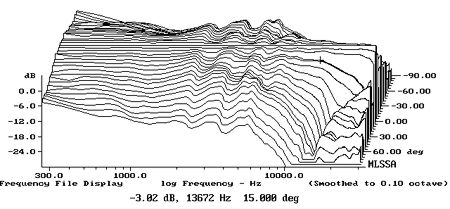
Fig.5 Gershman Opera Sauvage, lateral response family at 50", normalized to response on tweeter axis, from back to front: differences in response 90 degrees-5 degrees off-axis, reference response, differences in response 5 degrees-90 degrees off-axis.
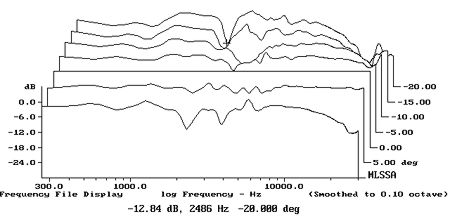
Fig.6 Gershman Opera Sauvage, vertical response family at 50", normalized to response on tweeter axis, from back to front: differences in response 20 degrees-5 degrees above axis, reference response, differences in response 5 degrees-10 degrees below axis.
Fig.7 shows the Gershman Opera Sauvage's response in my listening room. (Using an AudioControl 1/3-octave spectrum analyzer, I average 120 spectra taken for left and right speakers individually across a vertical rectangular window centered on my ear position. This spatial averaging minimizes the effect of room resonant modes on the measured response.) The upper-midrange and treble responses are pretty flat overall, though the slight lack of presence-region energy and the prematurely rolled-off top octave expected from the quasi-anechoic graphs make their presence known. The low bass is boosted by room boundary effects, resulting in impressive low-frequency extension. However, the lower-midrange and upper-bass regions are shelved-down, resulting in the lack of perceived loudness that I commented on in my auditioning notes. I wondered at first if this lack of integration between the woofers and midrange unit was due to a phasing problem. However, inverting the polarity of the woofers dropped the speaker's output in the 160-320Hz octave by another 6dB, indicating that that was not where the problem lay. All I can think is that this lack of energy in the region where so much music has much of its energy stems from the midrange unit's premature high-pass rolloff, seen in fig.3.
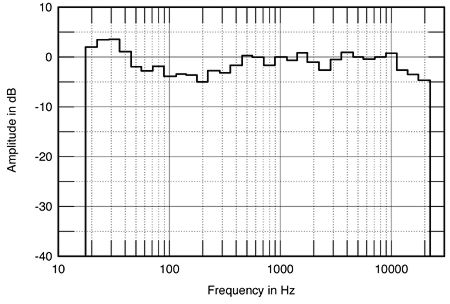
Fig.7 Gershman Opera Sauvage, spatially averaged, 1/3-octave response in JA's listening room.
In the time domain, the Opera Sauvage's step response (fig.8) indicates that the tweeter and midrange unit are connected in the same acoustic polarity, with the former's output leading the latter's by a fraction of a millisecond. Not apparent in this graph is the output of the woofers, which are connected in negative acoustic polarity. The Gershman's farfield cumulative spectral-decay plot (fig.9) is clean through most of the tweeter region, but some low-level hash is apparent in the mid-treble, most probably due to breakup modes in the midrange unit's cone. It is possible that this correlates with the aggressive edge I noted when I auditioned the speaker at high sound-pressure levels.
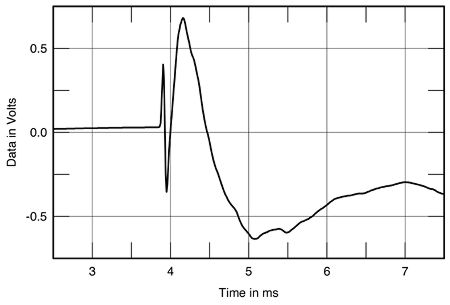
Fig.8 Gershman Opera Sauvage, step response on tweeter axis at 50" (5ms time window, 30kHz bandwidth).
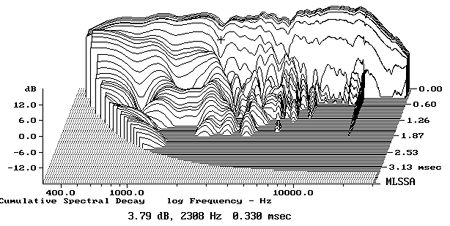
Fig.9 Gershman Opera Sauvage, cumulative spectral-decay plot at 50" (0.15ms risetime).
All in all, while there are some excellent aspects to the Gershman's measured performance, I was bothered by what appeared to be a less than optimally realized crossover between the woofers and the midrange unit. This can also be seen in Gershman's own measurements of the speaker, which I examined only after I had finished my own assessment.—John Atkinson
- Log in or register to post comments




































